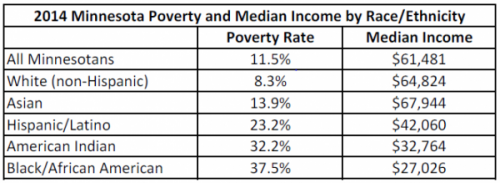Today’s Census update tells us a familiar story: Minnesota incomes are strong compared to much of the rest of the nation, but that isn’t the case for communities of color. The news is particularly troubling for black Minnesotans, whose incomes are more than 20 percent lower than before the Great Recession hit. The data are a clear call to action for policymakers, who should do more to ensure that the benefits of the economic recovery reaches all Minnesotans.
Minnesota’s poverty rate in 2014 was 11.5 percent, essentially unchanged from last year. The higher poverty rate for children also stayed flat at 14.9 percent. To put that in perspective, $24,250 is the current poverty line for a family of four.
The median household income in Minnesota was about $61,500 in 2014, showing no significant change from 2013. Minnesota’s median income puts us in 11th place among the 50 states and Washington, DC.
The most astonishing piece of data is that black Minnesotans’ incomes have decreased by an inflation-adjusted $7,700 since 2007, a drop of more than 20 percent. That includes a $4,500 drop from 2013 to 2014 alone.
In addition, the poverty rate for black Minnesotans has increased by nearly five percentage points. The poverty rate remains significantly higher for people of color in Minnesota. This is even true for Asian Minnesotans, who as a group have a relatively high median household income.

As we discussed yesterday, policy choices can lift families out of poverty. And they are particularly important during a time of slow wage growth — especially when many current and recent policies have served as barriers for people of color.
Last year, state policymakers took a step toward all Minnesotans participating in the state’s economic success when they raised the minimum wage, a change that doesn’t show up in today’s data. Other data tell us that the states with minimum wage increases saw greater growth in pay for the lowest-wage workers, and people of color are one group that is highly likely to see a boost in income from a higher minimum wage.
There are other ways to make economic opportunity available to all Minnesota workers. More than a million Minnesota workers — and nearly half of black workers and 60 percent of Hispanic workers — do not have earned sick leave. Legislation could make Minnesota a place where working parents are not forced to choose between losing wages (or getting fired) when illness strikes their family.
The state should continue to invest in MinnesotaCare and Medical Assistance. These often represent a hard-working family’s only affordable option for health coverage, particularly in communities of color. Policymakers can also eliminate the barriers to driver’s licenses, helping Minnesotans get safely to work regardless of their immigration status.
Policies like these will more firmly plant the ladder to the middle class in every corner of Minnesota. They can take us to a future where Census updates will tell a different story — one where poverty is declining and incomes are rising for all Minnesotans.
-Ben Horowitz